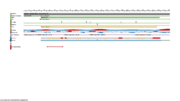User:Ophelie Lefort/Sandbox
From Proteopedia
|
This is a default text for your page Serine protease 57 (PRSS57). Click above on edit this page to modify. Be careful with the < and > signs. You may include any references to papers as in: the use of JSmol in Proteopedia [1] or to the article describing Jmol [2] to the rescue. NSP4 is one of the neutrophil serine protease in the cytoplasmic granules of neutrophils. This enzyme is expressed in bone marrow and takes part of the immune response against pathogens. NSP4 is found in the telomeric region of the chromosome 19.
FunctionRecruitement of neutrophils to the site of inflammation is the earliest defense reaction against pathogens. NSP4 is stored in the azurophilic granules which is a compartment of neutrophils. In response to neutrophil activation, NSP4 is released into the pericellular environment where microbes are after their phagocytosis. The serine protease 54 not only kill pathogens but also regulate the activity of immune mediators such as chemokines and lymphocytes. NSP4 alterates chemokines by proteolitically cleaving N-terminus of the chemokine. Furthermore, the caspase-like activity of PRSS57 can activate lymphocytes and the adaptive immune response. However, although NSP4 can inactivate some inflammatory processes, the neutrophil serine protease generally promotes than inhibits the inflammatory response.
DiseaseClaire RelevanceStructural highlightsThis is a sample scene created with SAT to by Group, and another to make of the protein. You can make your own scenes on SAT starting from scratch or loading and editing one of these sample scenes. The protein has a 283 amino-acids long sequence with two mainly domains . It forms a kind of elongate sphere of approximately 70Å large and 150Å long (dimensions: 70,37Å X 70,37Å X 105,02Å). The protein is composed of signal peptide (1-31) which leads to the location in azurophil granules [1] and allows its excretion. In addition there is a protease domain (32-283) which is a trypsin-like domain with a trypsin-like active site, according to the specificity for P1-Arg residues, but this domain can be an elastase-like active site according to the primary sequence (because of the presence of a swallow S1 pocket) specific to small aliphatic residues.[3]The active is form by 4 amino acids: Gly(189), Phe(190, Ser(216), D(226) The residue F190 obstructs the active site which could normally not links a P1-Arg. However, a study [4] considered the possibility that the two residues S216 and F190 of the active site can form a flexible gate which allows P1-Arg to enter. Then, the link between the active site and P1-Arg can be stabilized by a salt bridge interaction between S1-D226 and P1-Arg. The hypothesis of the flexible gate was confirmed by the same study. The mutations of S216 only, F190 only or both together show a forced full open gate is more efficient than a forced partially open gate. The conclusion is that the protease domain is a trypsin-like domain.
| ||||||||||||
References
<references/[1]>

